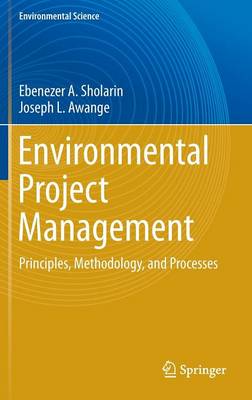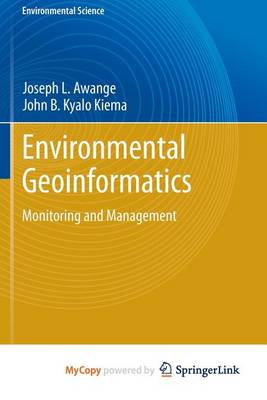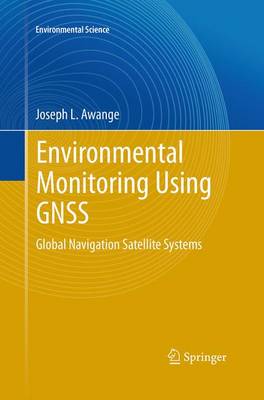Environmental Science and Engineering
3 total works
It is unique in that it clearly distinguishes between environmental project management (EnvPM) and green project management (GreenPM), and presents an amalgamation of environmental management and project management concepts, using geospatial methods to form an EnvPM concept. The book sets a benchmark for the professionalism with which environmental projects should be planned, executed, monitored, assessed and delivered. While primarily intended for professionals responsible for the management of environmental projects or interested in improving the overall efficiency of such projects, it is also a useful handbook for managers in the private, public and non-for-profit sectors. It is a valuable resource for students at both undergraduate and master’s levels and an indispensable guide for anyone wanting to develop their skills in modern project management, environmental management and geospatial techniques.
``We are the first generation to feel the impact of climate change, and the last generation that can do something about it.'' US President Obama's address to the United Nations on Climate Change and Global warming (2015)
hison: This book provides an in-depth, well-researched and science-based approach to applying key project-management and spatial tools and practices in environmental projects. An important read for leaders considering projects that balance social-economic growth against minimising its ill-effects on Planet Earth. - Todd Hutchison, Global Chairman of Peopleistic group.
There is no doubt that today, perhaps more than ever before, humanity faces a myriad of complex and demanding challenges. These include natural resource depletion and environmental degradation, food and water insecurity, energy shortages, diminishing biodiversity, increasing losses from natural disasters, and climate change with its associated potentially devastating consequences, such as rising sea levels.
These human-induced and natural impacts on the environment need to be well understood in order to develop informed policies, decisions, and remedial measures to mitigate current and future negative impacts. To achieve this, continuous monitoring and management of the environment to acquire data that can be soundly and rigorously analyzed to provide information about its current state and changing patterns, and thereby allow predictions of possible future impacts, are essential. Developing pragmatic and sustainable solutions to address these and many other similar challenges requires the use of geodata and the application of geoinformatics.
This book presents the concepts and applications of geoinformatics, a multidisciplinary field that has at its core different technologies that support the acquisition, analysis and visualization of geodata for environmental monitoring and management. We depart from the 4D to the 5D data paradigm, which defines geodata accurately, consistently, rapidly and completely, in order to be useful without any restrictions in space, time or scale to represent a truly global dimension of the digital Earth. The book also features the state-of-the-art discussion of Web-GIS.
The concepts and applications of geoinformatics presented in this book will be of benefit to decision-makers across a wide range of fields, including those at environmental agencies, in the emergency services, public health and epidemiology, crime mapping, environmental management agencies, tourist industry, market analysis and e-commerce, or mineral exploration, among many others.
The title and subtitle of this textbook convey a distinct message. Monitoring -the passive part in the subtitle - refers to observation and data acquisition, whereas management - the active component - stands for operation and performance. The topic is our environment, which is intimately related to geoinformatics. The overall message is: all the mentioned elements do interact and must not be separated. Hans-Peter B ahr, Prof. Dr.-Ing. Dr.h.c., Karlsruhe Institute of Technology (KIT), Germany.
Global Navigation Satellite Systems (GNSS) are revolutionizing the world in a way their original developers never envisaged. From being military “war” tools, GNSS satellites are rapidly becoming “peace” tools that play a potentially critical role in enabling changing environmental phenomenon that do not permit direct measurements to be remotely observed via their all-weather, highly accurate and continuously updatable positional time series. This is evident, for example, in their use in emerging environmental monitoring methods that are considered in this book. These include: GPS-based radio telemetry, which is enhancing ecological and conservation monitoring by more accurately mapping animal movements, their behaviours, and their impact on the environment; GNSS-meteorology, which is contributing to weather and climate change studies; GNSS-remote sensing, which, for example, allows the rapid monitoring of changes in fresh water resources and cryosphere; Geosensor network techniques, which are earning a crucial role in disaster response management; Epidemiology, for improved efficiency in tracking and studying the spread of infectious diseases and climate change effects on vector-borne diseases; and Economics, to provide data for the econometric modelling of casual impact of policies. In Environmental Impact Assessments (EIA), Strategic Environmental Assessments (SEA), and Sustainability Assessments (SA), GNSS, together with other spaced-based remote sensing techniques, are emerging, not only as modern tools that connect the developers to the community, but also provide information that support Multi-Criteria Analysis (MCA) methods, which inform decision making and policy formulations.
By bringing the two fields of geodesy (the parent of GNSS technology) and environmental studies (potential users of this technology), this book presents the concepts of GNSS in a simplified way that can, on the one hand, be understood and utilised by environmentalists, while on the other, outlines its potential applications to environmental monitoring and management for those engaged more with its technology, which hopefully will further energise the already innovative research that is being carried out. Lastly, this book is most relevant to all the professionals whose work is related to the environment such as hydrologists, meteorologists, epidemiologists, economist, and engineers, to name just a few.A comprehensive yet candid and compelling presentation of Global Navigation Satellite Systems and its application to environmental monitoring and a host of other socio-economic activities. This is an essential and new ground breaking reading for all professional practitioners and even academics seeking to study and become involved in using Global Navigation Satellite Systems in diverse fields ranging from environmental monitoring to economic activities such as monitoring weather and climate in order to design crop failure insurance.
Nathaniel O. Agola, Professor of Business and Financial Economics, Ritsumeikan University, Japan


